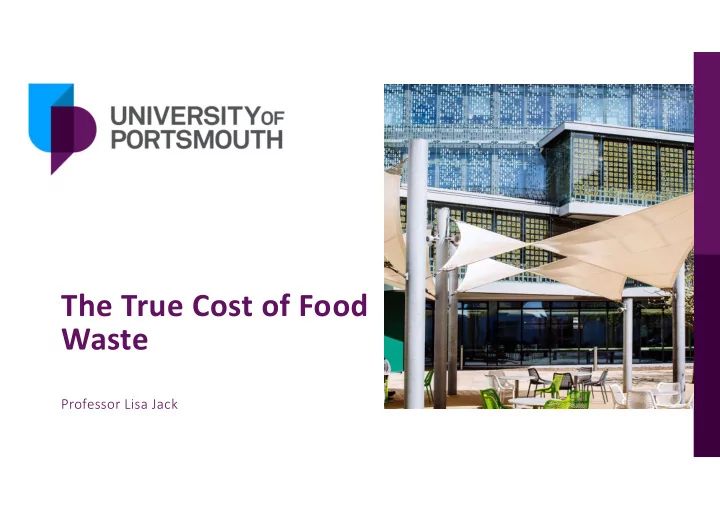

The True Cost of Food Waste Professor Lisa Jack
Previous Work • Researching the food industry for 20 years – accounting, performance measurement • Contributed to the ‘Elliott Review’ on food fraud; ‘The Cost of Food Crime’ for the FSA (pending) • Leading the ‘Food Cultures in Transition’ research group at UoP – over 35 researchers interested in and knowledgeable about people’s behaviour around food systems past, present and future.
Previous Work – True Cost of Returns To paraphrase a quote from the 1930s (Adrian Bell, Silver Ley ): The customer: • “For the privilege of buying a chicken prepared for the oven whenever you want you have to pay for all the days the chicken was there and you didn’t want it.” The Store (food waste adaptation): • “For giving the customer the opportunity to buy what they want, when they want, you have to pay for all the days that they leave you to dispose of the surplus.”
True cost of returns model – our starting point
Example possible costs and losses food waste Increased losses from waste Additional costs from waste • Increased write offs for foods • Increased internal theft • Incremental IT development, • Increased loss of maintenance & support, admin inventory/replacement costs • Additional costs of handheld & desktop devices • Security and storage of items in store before disposal – new assets • Wrap & packaging/unwrapping • Transportation Consequential losses from waste • Additional staff costs • Opportunity costs • Foods sent to recycling / landfill • Cost of management time that could have been sold • Commercial income lost
To calculate cost of waste you might need: Sales price of item Cost of sales of item Transaction cost per item of handling waste in Store (additional staff cost; security etc) Commercial income related to item Transaction cost per item for administration Cost of discounts given Transaction cost per item IT provision Costs of disposal – fees, transportation, etc % food wasted in store because unsellable Average net Income per item from 3 rd % food wasted in store because slow party (positive) or cost of waste disposal moving/obsolete (negative) % food wasted because of damaged packaging % foods sold at reduced rate Operating margin % Net margin before tax % % redistributed to people % sent to animal feed/reseller (income) No of food items in total % recycled (including energy recovery) No of food items sold No of items returned via home delivery % thrown away Average wage with on-costs rate of disposal (items lost/total no items) Increase or decrease in rate of disposals estimated as a result of an initiative.
Trial run figures for one SKU For a retailer with 0.8% rate of food waste, 10% gross profit margin, 2% operating profit margin, 1% net profit margin. Item retailing at £1.20. 1.5m items available for sale. Cost of disposal to be provided for even if 0% waste is £0.01 per item Maximum level of disposal before overall losses 16% An improvement in the rate of food waste of just 0.005% has the potential for a 200 basis point increase in net profit. Key factors: rate of waste, income from disposal, cost of disposal, incremental cost of additional infrastructure.
Comparison to WRAP equation • WRAP equation is global. • Our equations would work at SKU, Store, Company level • Breaks down different entry and exit routes for waste • Better idea of incremental costs • Looks at rates of disposal effecting net margins • Tells you what to track • Enables what-if analysis
Benefits of knowing the cost of food waste Provide Identifies net Places a value reasons to Places a value margin on unlock on prevention savings and philanthropic investment for work other cost- work prevention benefits
Entry and Exit Routes Circular Economy
Ben Dingley • Zero Food Waste Leader – Tesco UK
Questions for the Audience What implications Write What and actions What would comments in benefits do could you be the most the Chat/Q&A you see in imagine interesting box or this arising from categories indicate you’d research? the research to start on? like to speak! and its findings?
Getting involved Case studies : Desk based Short, structured development : detailed interviews, interviews : round table creation of a True Cost telephone/online discussions and site of Waste model . questionnaire based visits with 4 retailers discussions Sharing and/or Around 4 days input testing model over 12 Around 20-40 minutes over 6 months. months.
CONTACT: Lisa.Jack@port.ac.uk or colinmpeacock@ecr- shrink-group.com
Recommend
More recommend